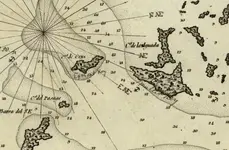Some research I've done has indicated that early explorers had the east side of Mullet Key as a place to get fresh water, just east of the anchorage on the above chart. You can walk around the trails through the woods, but nope, not detecting anywhere except the dry sand on the beach. It's a shame, as I bet some really great stuff is rotting away in the woods and just off shore.
There is absolutely no detecting on Egmont Key, even though they do constant beach nourishment there and mother nature keeps washing it back to sea.
I've asked, over and over again, everyone I run into (to include writing to the folks in Tallahassee) and nobody can give me an answer. I've asked how far from the beach does the park enforce the no detecting limit? Feet, yards, miles? Absolutely no body can give me an answer, but if I anchor just off shore and start detecting they call the marine patrol on me and send the coppers. Even they can't tell me where the park boundary is. We usually end up with, 'Come on buddy, just stop detecting so I can go away and stop asking me questions I can't answer.' (it's all done very politely trying to learn the correct laws so don't jump me about giving MD'ing a bad name) So I find it easier to just go somewhere else, knowing some great stuff is right there, and not going through another safety inspection.
And yep, Mullet Key is the entire land mass that Fort Desoto is on. The entire Key is part of the park. And if your on the north end of north beach, don't go near the raccoons with food. They cornered my wife and cleaned her out.









